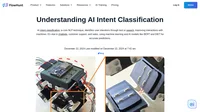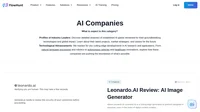Artificial Intelligence (AI) in transportation refers to the integration of AI technologies to optimize, automate, and improve various aspects of the transportation sector. This includes using machine learning, predictive analytics, and other AI-driven technologies to enhance vehicle safety, optimize routes, manage traffic, and even enable autonomous vehicles. AI in transportation aims to increase efficiency, safety, and sustainability while reducing costs and enhancing the overall user experience.
Expanded Insights on AI in Transportation
AI in transportation is revolutionizing how we move by leveraging advanced technologies that provide unprecedented levels of efficiency and safety. From self-driving cars to automated traffic management systems, AI is at the forefront of modernizing transportation infrastructures globally. The integration of AI into transportation systems not only optimizes operations but also supports sustainable practices by reducing emissions through efficient routing and vehicle management.
Key Components of AI in Transportation
- Predictive Maintenance: AI is used to predict when a vehicle or infrastructure component might fail. By analyzing data from sensors and historical maintenance records, AI algorithms can forecast issues before they occur, allowing for proactive maintenance. This reduces downtime, enhances safety, and saves costs associated with unexpected repairs.Predictive maintenance leverages AI to analyze vast amounts of data from IoT devices and sensors, predicting potential failures in vehicles or infrastructure components. This approach minimizes downtime and costs by enabling companies to address issues before they escalate into major problems. For instance, AI algorithms can identify patterns indicating a high likelihood of component failure, allowing for timely maintenance interventions.
- Autonomous Vehicles: AI powers self-driving cars, enabling them to navigate roads, recognize obstacles, and make real-time driving decisions without human intervention. Companies like Tesla and Waymo are leading in this field, utilizing AI to interpret sensor data and ensure safe vehicle navigation.Autonomous vehicles are at the pinnacle of AI innovation in transportation. These vehicles utilize computer vision, sensor fusion, and machine learning algorithms to interpret their environment and make driving decisions. As AI technology advances, the capabilities of autonomous vehicles are expected to extend beyond simple navigation to include complex decision-making processes that prioritize passenger safety and comfort.
- Fleet Management: AI optimizes the management of large fleets by providing insights into vehicle usage patterns, maintenance needs, and driver performance. This leads to better resource allocation, reduced operational costs, and improved efficiency.AI-driven fleet management systems offer comprehensive solutions that track vehicle health, optimize routes, and monitor driver behavior. These systems can automatically generate alerts for maintenance needs and optimize scheduling, effectively reducing operational costs and improving service efficiency.
- Traffic Management: AI systems analyze real-time data from traffic cameras, sensors, and GPS devices to optimize traffic flow, reduce congestion, and improve travel times. Smart traffic management systems dynamically adjust signal timings and reroute vehicles to enhance traffic efficiency.Smart traffic management utilizes AI to optimize traffic signal timing, manage congestion, and improve overall traffic flow. By analyzing data from various sources like cameras and GPS, AI can predict traffic patterns and suggest alternate routes, significantly reducing travel time and emissions.
- Route Optimization: AI algorithms determine the most efficient routes for vehicles by considering current traffic conditions, road closures, and weather. This is particularly beneficial for logistics and delivery services, reducing delivery times and operational costs.Route optimization algorithms use real-time traffic data, historical patterns, and environmental conditions to calculate the most efficient routes. This is crucial for logistics companies that aim to minimize delivery times and fuel consumption, thereby enhancing customer satisfaction and reducing environmental impact.
- Safety and Security: AI enhances transportation safety by monitoring data from various sensors to detect potential threats or unusual behaviors. This enables timely interventions and enhances overall safety.Safety systems powered by AI can detect anomalies and potential security threats through continuous monitoring of vehicle and environmental data. This proactive approach allows for immediate interventions, reducing risks associated with accidents and security breaches.
- Environmental Impact: AI contributes to environmental sustainability by optimizing routes, improving traffic flow, and enabling more efficient vehicle operations, thereby reducing emissions and fuel consumption.AI-driven transportation solutions are integral to promoting sustainable practices. By optimizing vehicle operations and traffic flow, AI helps reduce fuel consumption and emissions, contributing to cleaner and more sustainable urban environments.
Successful Examples of AI in Transportation
- Tesla: Tesla’s AI technology enables self-driving capabilities in its vehicles. The company uses AI to interpret sensor data, allowing vehicles to navigate autonomously while ensuring safety by detecting driver fatigue and preventing accidents.Tesla’s integration of AI in its self-driving technology showcases the potential for autonomous vehicles to operate safely and efficiently. The system’s ability to learn and adapt to new environments enhances its reliability and safety features.
- Waymo: Waymo, a leader in autonomous driving technology, uses AI to process data from sensors and cameras, enabling safe navigation of self-driving vehicles. Waymo’s robotaxi service operates without an onboard backup driver, showcasing the potential of AI in autonomous transportation.Waymo’s autonomous technology demonstrates significant advancements in AI-driven vehicle navigation, emphasizing safety and reliability. The company’s robotaxi service exemplifies the practical application of AI in real-world scenarios.
- UPS ORION System: UPS utilizes AI in its On-Road Integrated Optimization and Navigation (ORION) system to optimize delivery routes. This system saves millions of miles and gallons of fuel annually, demonstrating the efficiency and environmental benefits of AI in logistics.UPS ORION system is a prime example of AI’s impact on logistics, significantly reducing operational costs and environmental impact by optimizing delivery routes and schedules.
- Siemens Mobility: Siemens employs AI-based traffic management systems to analyze real-time traffic data and optimize signal timings, reducing congestion and improving urban mobility.Siemens’ AI-driven traffic management systems play a crucial role in enhancing urban mobility by reducing congestion and improving traffic flow through intelligent signal control.
- Hitachi’s Predictive Maintenance: Hitachi uses AI for predictive maintenance in fleet management, analyzing data to forecast maintenance needs and ensure the longevity of fleet assets.Hitachi’s predictive maintenance solutions leverage AI to enhance fleet reliability and efficiency, reducing unexpected downtimes and maintenance costs.
- Subaru’s Driver Monitoring System: Subaru’s AI-powered driver monitoring system enhances safety by detecting signs of driver fatigue and distraction, ensuring a safer driving experience.Subaru’s driver monitoring system exemplifies AI’s role in improving vehicle safety by actively monitoring driver behavior and providing timely alerts to prevent accidents.
Use Cases of AI in Transportation
- Predictive Maintenance: AI predicts vehicle maintenance needs, reducing downtime and enhancing safety. For example, Delta Airlines uses AI to anticipate aircraft maintenance, ensuring timely interventions and safety.Predictive maintenance in aviation and automotive industries showcases AI’s ability to enhance operational safety and efficiency by predicting and addressing maintenance needs before they cause disruptions.
- Traffic Flow Optimization: AI systems like those employed in Los Angeles adjust traffic signals dynamically based on real-time data, leading to smoother commutes and reduced emissions.The implementation of AI-driven traffic flow optimization systems in cities like Los Angeles demonstrates a significant reduction in congestion and emissions, contributing to improved urban livability.
- Autonomous Drones: AI-powered drones are used in logistics for efficient cargo delivery, reducing reliance on traditional logistics networks and offering fast, cost-effective delivery options.The use of AI in autonomous drones for delivery enhances logistics efficiency and reduces operational costs, providing a scalable solution for last-mile delivery challenges.
- Smart Parking: AI helps in identifying available parking spaces, reducing the time spent searching for parking and easing urban traffic congestion.Smart parking solutions powered by AI optimize the use of available parking spaces, reducing traffic congestion and enhancing the overall urban driving experience.
- Intelligent Transportation Systems (ITS): Cities like Singapore use AI in ITS for real-time traffic monitoring and management, enhancing urban mobility and reducing environmental impact.Intelligent Transportation Systems (ITS) leverage AI to integrate various transportation data sources, providing comprehensive solutions for traffic management and urban planning.
- Customer Service Chatbots: AI chatbots improve customer service for transportation providers by handling inquiries and providing instant support, enhancing customer satisfaction.AI-driven customer service solutions in transportation improve user experience by providing quick and accurate responses to customer inquiries, increasing satisfaction and loyalty.
Challenges and Considerations
- Integration with Legacy Systems: AI solutions must integrate seamlessly with existing transportation infrastructure, which may require updates or modifications.The integration of AI technologies with legacy systems poses significant challenges, requiring careful planning and execution to ensure compatibility and functionality.
- Data Privacy and Security: The use of AI requires handling vast amounts of data, necessitating robust data governance and privacy measures.Ensuring data privacy and security in AI applications is critical, necessitating stringent measures to protect sensitive information and maintain user trust.
- Regulatory Compliance: AI deployment in transportation must adhere to regulatory standards and safety protocols to ensure public trust and acceptance.Regulatory compliance is a key consideration in AI implementation, requiring adherence to established standards and protocols to ensure safety and legality.
- Ethical Considerations: The development and deployment of AI in transportation must consider ethical implications, particularly concerning autonomous vehicles and data privacy.Ethical considerations in AI deployment involve addressing potential biases, ensuring transparency, and maintaining user privacy and rights.
- Technological Limitations: Challenges such as situational conditions, data reliability, and sensor accuracy must be addressed to ensure the effective deployment of AI solutions.Technological limitations pose significant challenges to AI deployment, necessitating continuous research and development to overcome these barriers and enhance system performance.
The Future of AI in Transportation
The future of AI in transportation holds immense potential. Advancements in AI technologies will continue to drive innovation in autonomous vehicles, smart logistics, and urban mobility. Collaborative efforts between governments, industry leaders, and technology developers will be essential to address challenges and fully leverage AI’s transformative potential in transportation. As AI technology evolves, it will redefine how we move and interact with transportation systems, offering new opportunities for efficiency, safety, and sustainability.
The transportation industry is on the cusp of a technological revolution, with AI as a driving force in reshaping the future of mobility. By embracing AI innovations, the sector is poised to achieve significant advancements in efficiency, safety, and environmental sustainability, fundamentally transforming how we experience transportation.
Understanding AI Intent Classification
Unlock the potential of AI intent classification with FlowHunt. Enhance chatbot efficiency, customer support, and user experience today!
Data-backed Content With No Fluff
Create data-driven content with FlowHunt’s AI tools. From idea generation to editing, streamline your process for engaging, SEO-optimized results!
Phantom.ai: Autonomous Driving AI
Phantom.ai leads in ADAS and autonomous driving tech, offering AI-driven safety, efficiency, and customizable solutions for OEMs. Explore now!



